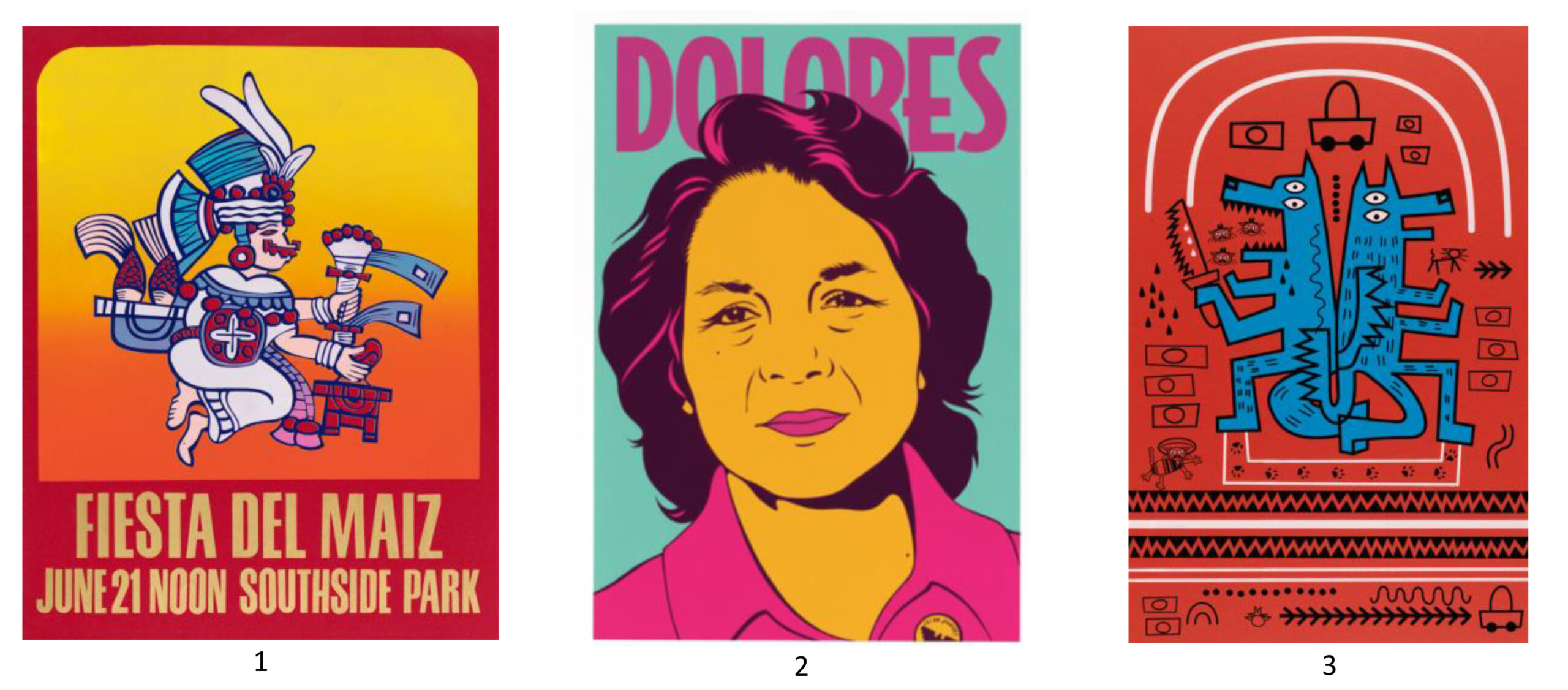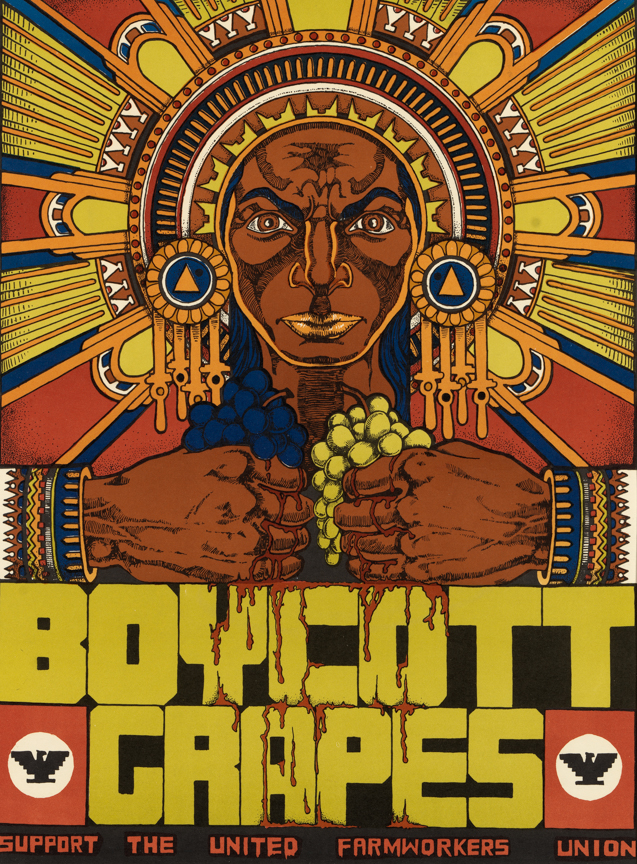¡Printing the Revolution! The Rise and Impact of Chicano Graphics,
1965 to Now
June 28–September 29, 2024

NASHVILLE, Tenn. (May 22, 2024)—The Frist Art Museum presents ¡Printing the Revolution! The Rise and Impact of Chicano Graphics, 1965 to Now, an exhibition that explores how Chicano activist artists forged a remarkable and enduring legacy of politically engaged printmaking rooted in cultural expression and social justice movements. Organized by the Smithsonian American Art Museum, the exhibition will be on view in the Frist’s Upper-Level Galleries from June 28 through September 29, 2024.
¡Printing the Revolution! is drawn from the Smithsonian’s extensive collection of Chicano graphics—the largest museum collection of its kind on the East Coast—and features nearly 120 works—ranging from traditional screen prints to digital graphics and augmented reality projects—by more than 70 artists. The exhibition examines how graphic arts have been utilized to build community, engage the public around social concerns, and wrestle with shifting notions of the term Chicano—once a derogatory term for people of Mexican heritage that was defiantly adopted in the 1960s and 1970s as a sign of a new political and cultural identity.
“Inspired by the civil rights and anti-war movements of the 1960s and beyond, Chicano artists used prints and posters to reflect their culture and advocate for equal justice and human dignity for their communities and other marginalized people around the world,” writes Frist Art Museum chief curator Mark Scala.
¡Printing the Revolution! extends the artistic calls for social justice and political awakening that were central to the Frist’s 2007 Mexico and Modern Printmaking: A Revolution in the Graphic Arts, 1920–1950, which featured works by such icons as Diego Rivera and José Clemente Orozco. Both exhibitions underscore the idea that, as an affordable and easy reproduceable medium, prints can reach an exceptionally wide audience. ¡Printing the Revolution! continues this narrative by showing how posters, often marked by vibrant colors, bold lettering, and striking images, have effectively communicated the prevailing social causes of their day—labor strikes, immigrant rights, opposition to the Vietnam War—and been a tool for forging community. By highlighting previously marginalized voices, including women and LGBTQIA+ artists, the exhibition offers an expanded view of American art and the history of graphic arts.
Organized thematically, the exhibition begins with the section “A New Chicano World” showing Chicano artists embracing and projecting their ideals of a distinct bicultural identity. Expressions of pride can be seen in such works as Gilbert “Magu” Luján’s festive and funky Cruising Turtle Island, showing a low-rider cruising through a neon-lit desert, densely packed and teeming with activity.
“Urgent Images” confronts issues such as workers’ rights, migration and deportation, and police brutality. On view are posters supporting the United Farm Workers union (UFW), which was founded in the 1960s to combat the intolerable working conditions of California’s migrant laborers. Graphic artists supported the movement, as seen in Xavier Viramontes’s poster, Boycott Grapes. With its subject’s intense facial expression, Aztec-style headdress, and strong farmworker hands crushing grapes, this was a fierce call to action against the exploitative labor practices of grape growers.

The section “Changemakers” includes portraits of advocates for political, civil, and human rights. These are adapted from historical photographs, with such figures as Frida Kahlo and Mexican revolutionary Emiliano Zapata rendered in patches of bright color and bold letters evoking the graphic style of pop art.
“Digital Innovations and Public Interventions” shows how artists use electronic media to reach new audiences. Favianna Rodriguez’s 2012 online image Mi Cuerpo. Yo Decido (My Body. I Decide.) has notable relevance today after the Supreme Court overturned Roe v. Wade in 2022. Likewise, her Migration Is Beautiful, showing a monarch butterfly as a symbol of migratory passage,challenges anti-migrant sentiments in the United States and elsewhere.
The final section, “Reimagining National and Global Histories,” shows Chicano printmakers expressing solidarity for people around the world who, like them, struggle for social justice. Many address genocides committed against Indigenous peoples, while others focus on the Cuban Revolution, the Vietnam War, the civil rights movement, and Apartheid in South Africa. Beyond the specific political cause promoted by each work is a broad humanitarian perspective that links people across time and place.
Opening Program
Thursday, June 27
Curator’s Perspective: ¡Printing the Revolution! Presented by E. Carmen Ramos, PhD
6:30 p.m.
Join exhibition curator E. Carmen Ramos for this lecture that explores the remarkable history of printmaking by Chicano artists. Learn how artists in the exhibition build community, engage with social justice concerns, and assert the value of Mexican American culture and history through their innovative uses of graphic arts.
E. Carmen Ramos is the chief curatorial and conversation officer at the National Gallery of Art in Washington, DC. She was previously the acting chief curator and curator of Latinx art at the Smithsonian American Art Museum (SAAM). During her tenure at SAAM, Ramos expanded the museum’s leading collection of Latinx art with an eye toward challenging the exclusion of Latinx art from US art history and capturing the broad aesthetic and regional range of the field. She curated major exhibitions, including ¡Printing the Revolution! The Rise and Impact of Chicano Graphics, 1965 to Now. Other notable exhibitions include Tamayo: The New York Years (2017), Down These Mean Streets: Community and Place in Urban Photography (2017), and Our America: The Latino Presence in American Art (2013), which traveled to eight cities across the country and received a 2014 Excellence Award from the Association of Art Museum Curators.
Ramos holds a PhD and MA in art history from the University of Chicago and a BA in art history and psychology from New York University. She serves on the board of the Association of Art Museum Curators and on the editorial board of UCLA’s journal Latin American and Latinx Visual Culture.
Exhibition Credit
¡Printing the Revolution! The Rise and Impact of Chicano Graphics, 1965 to Now is organized by the Smithsonian American Art Museum with generous support from The Latino Initiatives Pool, administered by the Smithsonian Latino Center, Michael Abrams and Sandra Stewart, The Honorable Aida Alvarez, Joanne and Richard Brodie Exhibitions Endowment, James F. Dicke Family Endowment, Sheila Duignan and Mike Wilkins, Ford Foundation, Dorothy Tapper Goldman, HP, William R. Kenan Jr. Endowment Fund, Robert and Arlene Kogod Family Foundation, Lannan Foundation, and Henry R. Muñoz, III and Kyle Ferari-Muñoz.
Supporter Acknowledgment
Supported in part by the Sandra Schatten Foundation and Ameriprise Financial
Spanish translation and program sponsor: The Center for Latin American, Caribbean, and Latinx Studies at Vanderbilt University
The Frist Art Museum is supported in part by The Frist Foundation, Metro Arts, the Tennessee Arts Commission, and the National Endowment for the Arts.
Image Credits
1. Luis C. González. Fiesta del Maiz, 1979. Screenprint on paper; 28 x 22 in. Smithsonian American Art Museum, Museum purchase through the Patricia Tobacco Forrester Endowment, 2020.47.2. © 1979, Luis C. González
2. Barbara Carrasco. Dolores, 1999. Screenprint on paper; 26 X 18 in. Smithsonian American Art Museum, Museum purchase through the Frank K. Ribelin Endowment, 2020.22.7. © 1999, Barbara Carrasco
3. Michael Menchaca. El Coyote, 2010. Screenprint on paper; 40 x 26 in. Smithsonian American Art Museum, Gift of Drs. Harriett and Ricardo Romo, 2019.50.29. © 2010, Michael Menchaca
4. Xavier Viramontes. Boycott Grapes, Support the United Farm Workers Union, 1973. Offset lithograph on paper; 21 3/4 x 16 in. Smithsonian American Art Museum, Gift of Tomás Ybarra-Frausto, 1995.50.58. © 1973, Xavier Viramontes
Connect with us @FristArtMuseum #TheFrist
FOR ADDITIONAL INFORMATION
Buddy Kite: 615.744.3351, bkite@FristArtMuseum.org
Ellen Jones Pryor: 615.243.1311, epryor@FristArtMuseum.org
